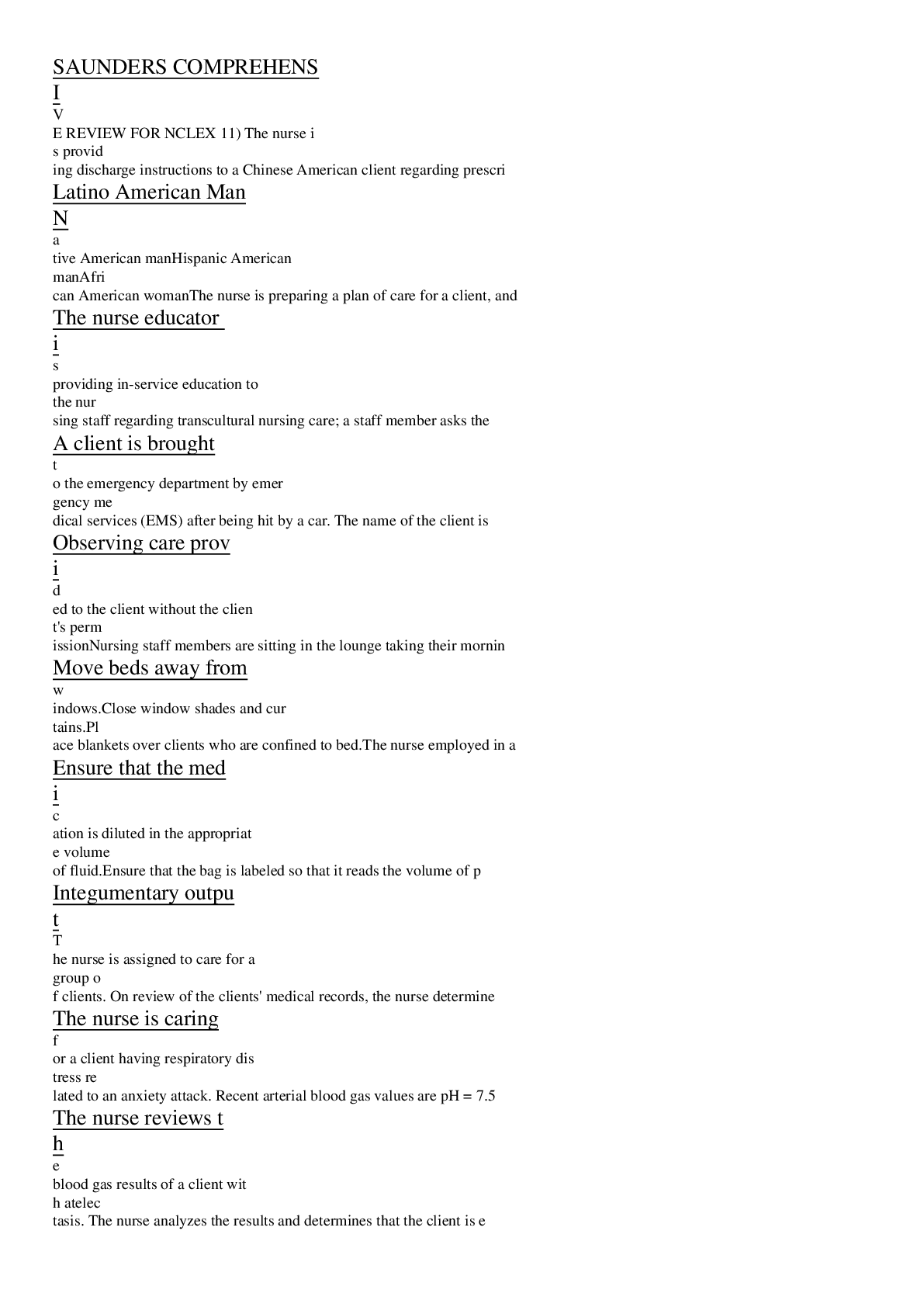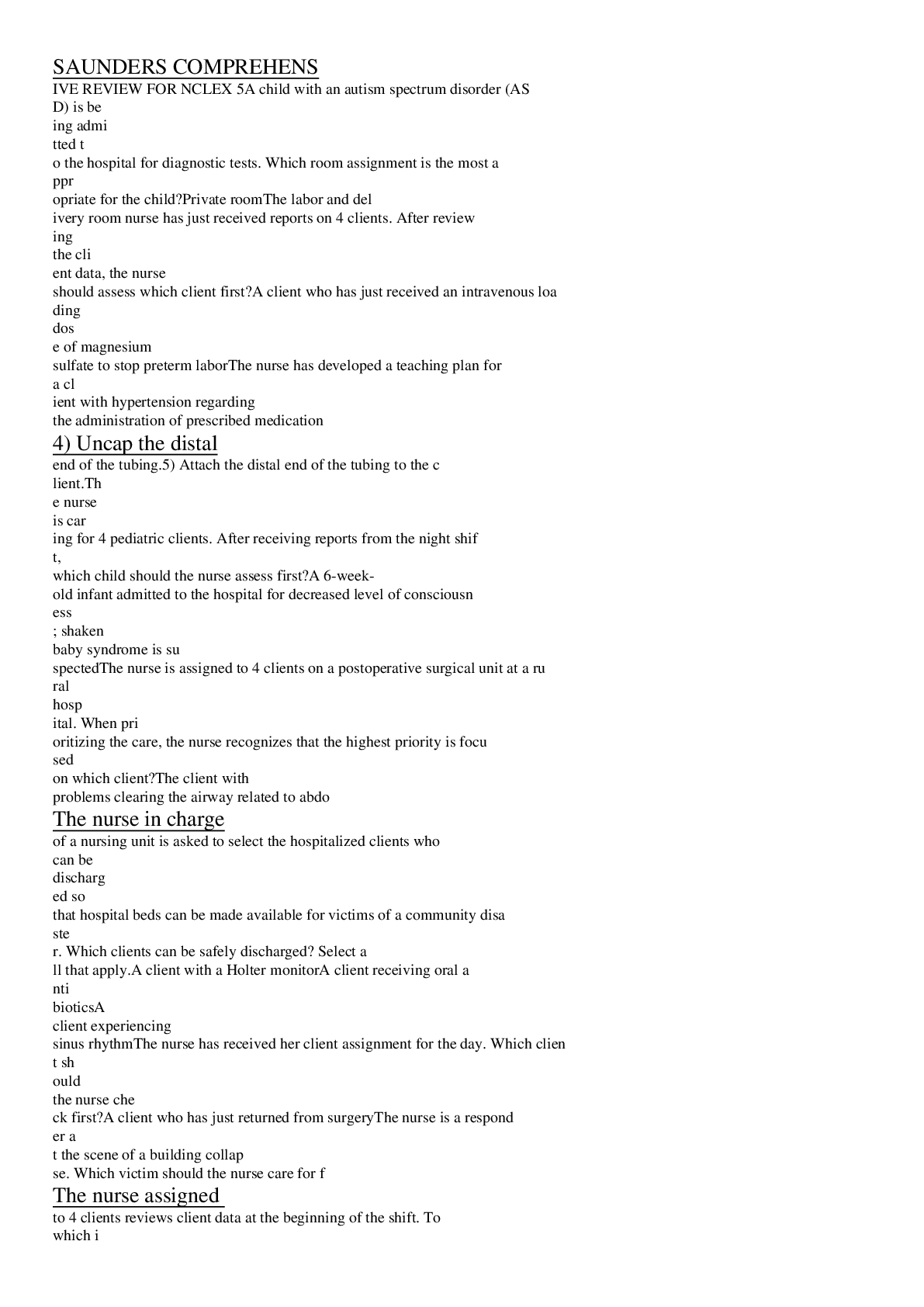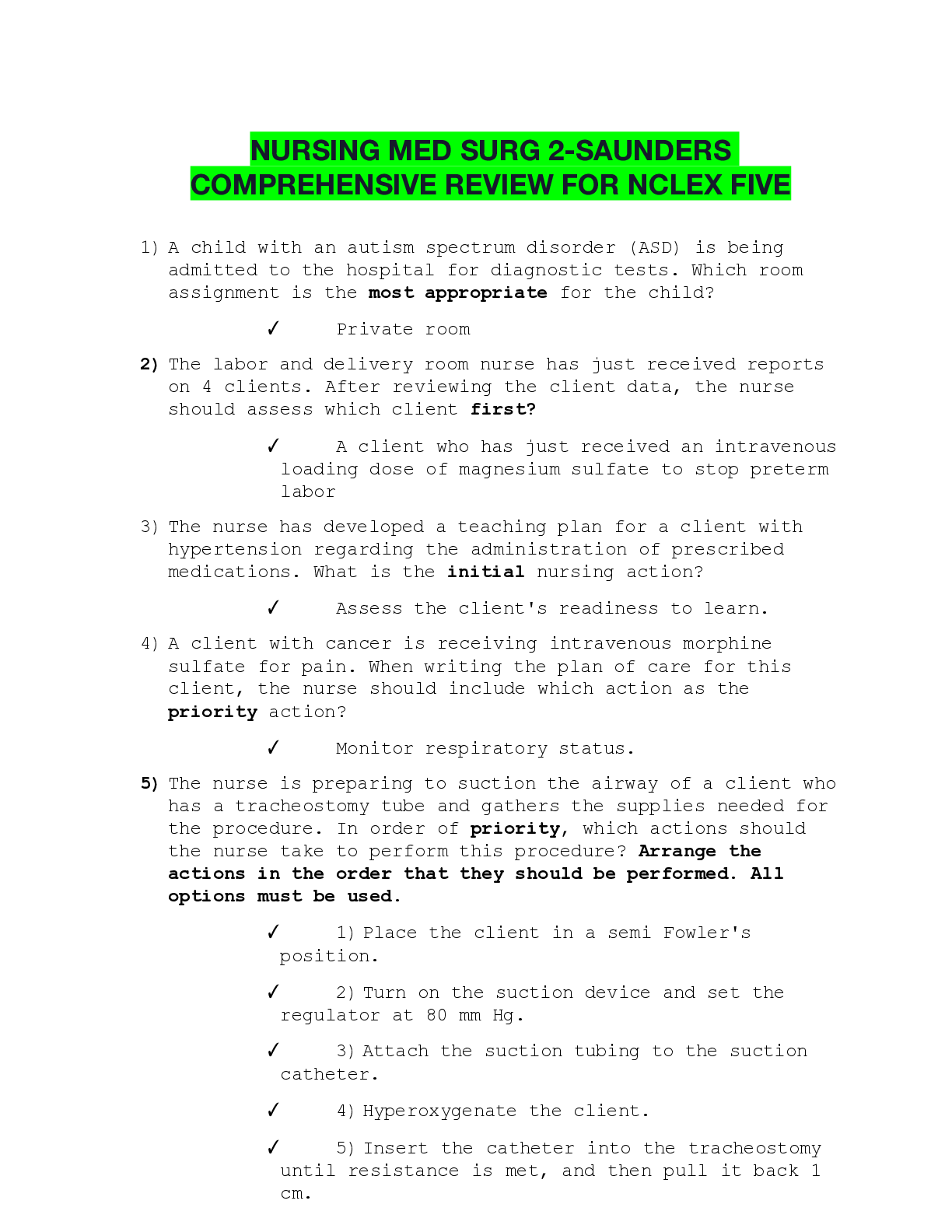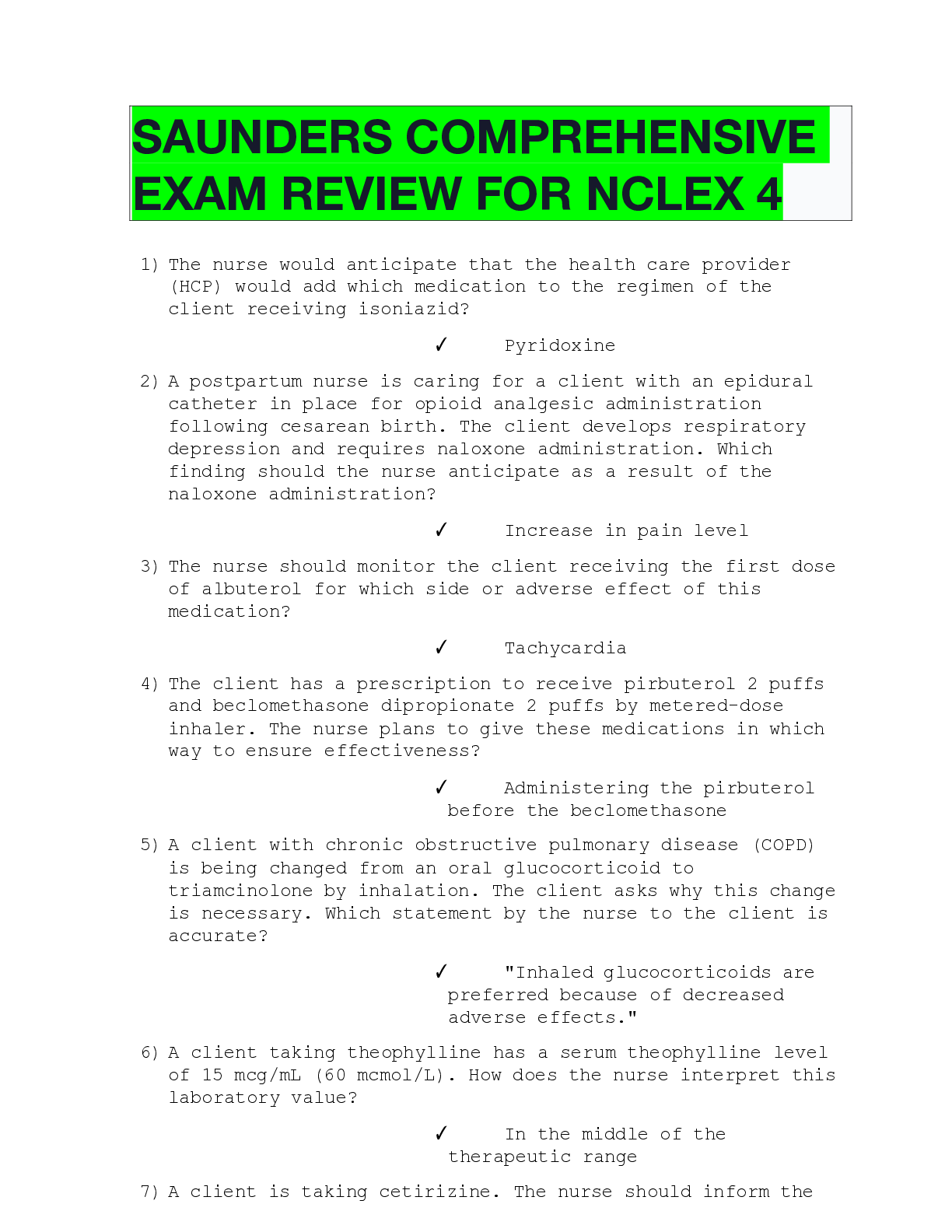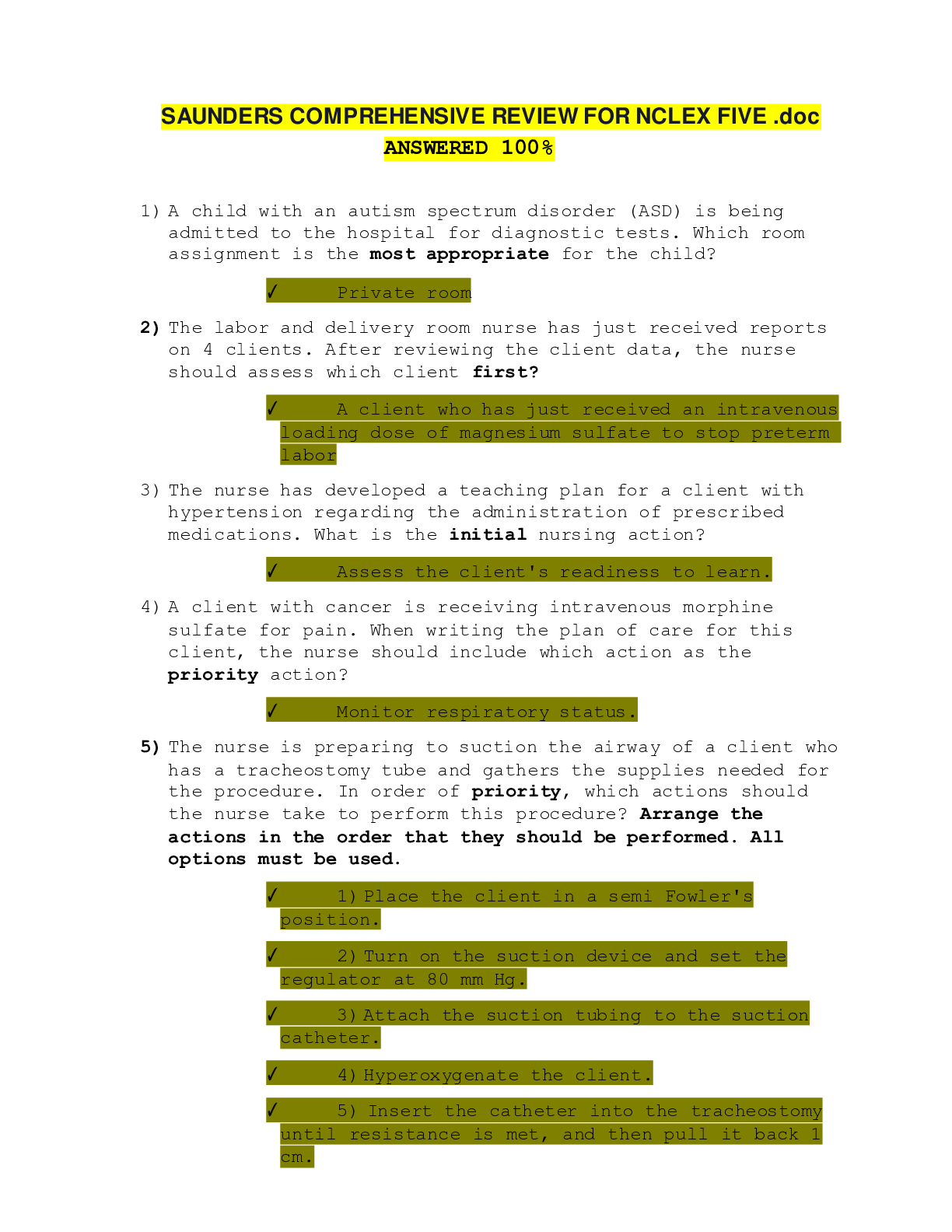*NURSING > EXAM > SAUNDERS COMPREHENSIVE REVIEW FOR NCLEX 4_2022/2023 | MED SURG 2 SAUNDERS COMPREHENSIVE REVIEW FOR N (All)
SAUNDERS COMPREHENSIVE REVIEW FOR NCLEX 4_2022/2023 | MED SURG 2 SAUNDERS COMPREHENSIVE REVIEW FOR NCLEX 4_LATEST
Document Content and Description Below
SAUNDERS COMPREHENSIVE REVIEW FOR NCLEX 4_2022/2023 | MED SURG 2 SAUNDERS COMPREHENSIVE REVIEW FOR NCLEX 4 210+ pages 1141 questions and answers. 1) The nurse would anticipate that the health care... provider (HCP) would add which medication to the regimen of the client receiving isoniazid? ⎫ Pyridoxine 2) A postpartum nurse is caring for a client with an epidural catheter in place for opioid analgesic administration following cesarean birth. The client develops respiratory depression and requires naloxone administration. Which finding should the nurse anticipate as a result of the naloxone administration? ⎫ Increase in pain level 3) The nurse should monitor the client receiving the first dose of albuterol for which side or adverse effect of this medication? ⎫ Tachycardia 4) The client has a prescription to receive pirbuterol 2 puffs and beclomethasone dipropionate 2 puffs by metered-dose inhaler. The nurse plans to give these medications in which way to ensure effectiveness? ⎫ Administering the pirbuterol before the beclomethasone 5) A client with chronic obstructive pulmonary disease (COPD) is being changed from an oral glucocorticoid to triamcinolone by inhalation. The client asks why this change is necessary. Which statement by the nurse to the client is accurate? ⎫ "Inhaled glucocorticoids are preferred because of decreased adverse effects." 6) A client taking theophylline has a serum theophylline level of 15 mcg/mL (60 mcmol/L). How does the nurse interpret this laboratory value? ⎫ In the middle of the therapeutic range 7) A client is taking cetirizine. The nurse should inform the client of which side effect of this medication? ⎫ Drowsiness 8) A client is scheduled to receive acetylcysteine 20% solution diluted in 0.9% normal saline by nebulizer. Which outcome would the nurse expect as a result of the administration of this medication? ⎫ Thinning of respiratory secretions 9) The health care provider prescribes cromolyn for the client with asthma. The nurse identifies that the client correctly understands the purpose of this medication when the client states that the medication will produce which effect? ⎫ 10) The nurse is teaching a client about the effects of diphenhydramine, an ingredient in the cough suppressant prescribed for the client. The nurse should plan to tell the client to take which measure while taking this medication? ⎫ Avoid activities requiring mental alertness. 11) The health care provider (HCP) has prescribed codeine sulfate for a client with a nonproductive cough to suppress the cough reflex. The nurse should teach the client to monitor for which side effect of the medication? ⎫ Constipation 12) A client has begun therapy with a xanthine bronchodilator. The nurse determines that the client understands dietary alterations if the client states to limit which items while taking this medication? Select all that apply. ⎫ Coffee ⎫ Chocolate 13) Which supplies should the nurse obtain for the administration of ribavirin to a hospitalized child with respiratory syncytial virus (RSV)? ⎫ A mask and pair of goggles 14) The nurse is documenting information in a client's chart when the electrocardiogram telemetry alarm sounds, and the nurse notes that the client is in ventricular tachycardia (VT). The nurse rushes to the client's bedside and should perform which assessment first? ⎫ Check responsiveness 15) A client is brought into the emergency department in ventricular fibrillation (VF). The nurse prepares to defibrillate by placing defibrillation pads on which part of the chest? ⎫ To the right of the sternum and to the left of the precordium 16) An adult client has been unsuccessfully defibrillated for ventricular fibrillation, and cardiopulmonary resuscitation (CPR) is resumed. The nurse confirms that CPR is being administered effectively by noting which action ⎫ The carotid pulse is palpable with each compression. 17) The nurse is assigned the care of a client who experienced a myocardial infarction and is being monitored by cardiac telemetry. The nurse notes the sudden onset of this cardiac rhythm on the monitor. The nurse should immediately take which action? Refer to Figure. View Figure ⎫ Initiate cardiopulmonary resuscitation (CPR). 18) To perform defibrillation, the defibrillator pads should be placed in which areas of the client's chest? ⎫ To the right of the sternum just below the clavicle and to the left side, just below and to the left of the pectoral muscle 19) The nurse is caring for a client who is pulseless and experiencing this dysrhythmia. Which interventions should the nurse anticipate implementing in collaboration with the health care provider (HCP)? Select all that apply. Refer to Figure. View Figure ⎫ Prepare to administer amiodarone. ⎫ Prepare to administer epinephrine. ⎫ Provide cardiopulmonary resuscitation (CPR). 20) The nurse is performing cardiopulmonary resuscitation (CPR) on a client who has had a cardiac arrest. An automatic external defibrillator (AED) is available to treat the client. Which activity will allow the nurse to assess the client's cardiac rhythm? ⎫ Apply adhesive patch electrodes to the chest and move away from the client. 21) The nurse is teaching adult cardiopulmonary resuscitation (CPR) guidelines to a group of laypeople. The nurse observes the group correctly demonstrate 2-rescuer CPR when which ratio of compressions to ventilations is performed on the mannequin? ⎫ 30:2 22) The nurse is teaching cardiopulmonary resuscitation (CPR) to a group of community members. The nurse tells the group that when chest compressions are performed on infants, the sternum should be depressed how far? ⎫ About 1½ inches (4 cm) 23) The nursing instructor teaches a group of students about cardiopulmonary resuscitation. The instructor asks a student to identify the most appropriate location at which to assess the pulse of an infant younger than 1 year of age. Which response would indicate that the student understands the appropriate assessment procedure? ⎫ Brachial artery 24) The nurse is conducting a basic life support (BLS) recertification class and is discussing chest compressions in a pregnant woman. The nurse should tell the class that which action should be taken in an advanced pregnancy client whose fundal height is at or above the umbilicus? ⎫ Maintain manual left uterine displacement during compressions. 25) The nurse is initiating 1-rescuer cardiopulmonary resuscitation on an adult client. The nurse should place the hands in which position to begin chest compressions? ⎫ On the lower half of the sternum 26) The nurse walking in a downtown business area witnesses a worker fall from a ladder. The nurse rushes to the victim, who is unresponsive. A layperson is attempting to perform resuscitative measures. The nurse should intervene if which action by the layperson is noted? ⎫ Use of the head tilt–chin lift 27) The nurse notes that a 14-year-old child is choking but is awake and alert at this time. The nurse rushes to perform the abdominal thrust maneuver. The child becomes unconscious. What procedure should the nurse perform next? ⎫ Start chest compressions. 28) The nurse assigned to the pediatric unit finds an infant unresponsive and without respirations or a pulse. What is the nurse's next action after calling for help? ⎫ Perform compressions at 100 to 120 times per minute. 29) The nurse is undergoing annual recertification in basic life support (BLS). The BLS instructor asks the nurse to identify the pulse point to use when determining pulselessness on an infant. Which response by the nurse identifies the most appropriate pulse point? ⎫ Brachial 30) External public access defibrillator (PAD) interprets that the rhythm of a pulseless victim is ventricular fibrillation and advises defibrillation. Which action should the rescuer take next? ⎫ Order people away from the client, charge the machine, and depress the discharge buttons. 31) Cardiopulmonary resuscitation (CPR) is immediately initiated on a client who is unconscious and has no pulse. A monitor is attached and it is determined that the rhythm is shockable, and defibrillation with 1 shock is delivered. Which action should the nurse plan to take next? ⎫ Perform CPR for 5 cycles, and then defibrillate again if the rhythm is shockable. 32) The nurse has completed 5 cycles of compressions after beginning cardiopulmonary resuscitation (CPR) on a hospitalized adult client who experienced unmonitored cardiac arrest. What should the nurse plan to do next? ⎫ Charge the defibrillator. 33) The nurse is teaching chest compressions for cardiopulmonary resuscitation (CPR) to a group of lay clients. Which behavior by one of the participants indicates a need for further teaching? ⎫ Letting the right and left fingers rest on the chest 34) In order of priority, how should the nurse perform abdominal thrusts on an unconscious adult? Arrange the actions in the order that they should be performed. All options must be used. ⎫ 1,2,3,4,5 35) One unit of packed red blood cells has been prescribed for a client with severe anemia. The client has received multiple transfusions in the past, and it is documented that the client has experienced urticaria-type reactions from the transfusions. The nurse anticipates that which medication will be prescribed before administration of the red blood cells to prevent this type of reaction? ⎫ Diphenhydramine 36) The nurse has a prescription to administer whole blood to a client who does not currently have an intravenous (IV) line inserted. When obtaining supplies to start the blood infusion, the nurse should select an angiocatheter of at least which size? ⎫ 19 gauge 37) A client has experienced high blood pressure and crackles in the lungs during previous blood transfusions. The client asks the nurse whether it is safe to receive another transfusion. The nurse explains that which medication most likely will be prescribed before the transfusion is begun? ⎫ Furosemide 38) The nurse is told by a health care provider that a client in hypovolemic shock will require plasma expansion. The nurse should prepare which supplies for transfusion? ⎫ Bottle of albumin with vented tubing 39) The nurse has discontinued a unit of blood that was infusing into a client because the client experienced a transfusion reaction. After documenting the incident appropriately, the nurse sends the blood bag and tubing to which department? ⎫ Blood bank 40) The nurse has just obtained a unit of blood from the blood bank to transfuse into a client as prescribed. Before preparing the blood for transfusion, the nurse looks for which member of the health care team to assist in checking the unit of blood? ⎫ Registered nurse (RN) 41) The nurse is picking up a unit of packed red blood cells at the hospital blood bank. After putting the pen down, the nurse glances at the clock, which reads 1300. The nurse calculates that the transfusion must be started by which time? ⎫ 1330 42) The nurse enters a client's room to assess the client, who began receiving a blood transfusion 45 minutes earlier, and notes that the client is flushed and dyspneic. On assessment, the nurse auscultates the presence of crackles in the lung bases. The nurse determines that this client most likely is experiencing which complication of blood transfusion therapy? ⎫ Circulatory overload 43) The nurse is monitoring a client who is receiving a blood transfusion. After 30 minutes of the infusion, the client begins to have chills and back pain. His temperature is 100.1°F (37.8°C). What action should the nurse take first? ⎫ Discontinue the infusion and start an infusion of normal saline using new tubing. 44) The nurse enters the room of a client who began receiving a blood transfusion 45 minutes earlier to check on the client. The client is complaining of "itching all over" and has a generalized rash. The client's temperature has not changed from baseline and the lungs are clear to auscultation. Which complication of blood transfusion therapy should the nurse determine that this client is most likely experiencing? ⎫ Allergic transfusion reaction 45) A unit of platelets was just received from the blood bank for transfusion to an assigned client. The nurse should select tubing with which feature for the transfusion? ⎫ An in-line filter 46) The nurse overhears a health care provider (HCP) stating that a client diagnosed with disseminated intravascular coagulation (DIC) requires a transfusion. Which blood product should the nurse anticipate that the HCP will write a prescription for? ⎫ Cryoprecipitate 47) The nurse is assisting in monitoring a client who is receiving a transfusion of packed red blood cells (PRBCs). Before leaving the room, the nurse tells the client to immediately report which symptoms of a transfusion reaction? Select all that apply. ⎫ Chills ⎫ Chest pain ⎫ Lower back pain ⎫ Difficulty breathing 48) A child is receiving succimer for the treatment of lead poisoning. The nurse should monitor which most important laboratory result? ⎫ Blood urea nitrogen level 49) A client with a probable minor head injury resulting from a motor vehicle crash is admitted to the hospital for observation. The nurse leaves the cervical collar applied to the client in place until when? ⎫ The results of spinal radiography are known 50) A client experienced an open pneumothorax (sucking wound), which has been covered with an occlusive dressing. The client begins to experience severe dyspnea, and the blood pressure begins to fall. The nurse should first perform which action? ⎫ Remove the dressing. - - - - - - - - - 1135. A hospitalized client tells the nurse that a living will is being prepared and that the lawyer will be bringing the will to the hospital today for witness signatures. The client asks the nurse for assistance in obtaining a witness to the will. Which response by the nurse is most appropriate? ⎫ "I will call the nursing supervisor for assistance regarding your request." 1136. The nurse has made an error in documenting an assessment finding in the client's record. What action should the nurse take to correct the error? ⎫ Draw a line through the error, initial and date the line, and then provide the correct information. 1137. The nurse hears a client calling out for help and finds the client lying on the floor. The nurse performs an assessment and assists the client back to bed. The health care provider is notified of the incident, and the nurse completes an incident report. What should the nurse document on the incident report? ⎫ The client was found lying on the floor. 1138. A homeless client comes to the emergency department complaining of severe pain in the toes of both feet. On assessment, it is found that all of the toes are black in color and that amputation is necessary. The client refuses the surgery and insists on returning to street living. Which describes the next appropriate action to take? ⎫ Discuss the surgical procedure and its purpose with the client, and encourage the client to talk about concerns and feelings. 1139. The client with a perforated gastric ulcer who is scheduled for emergency surgery cannot sign the operative consent form because of sedation with opioid analgesics. The nurse should take which priority action? ⎫ Obtain telephone consent from the family member witnessed by 2 authorized individuals. 1140. The nurse manager is reviewing documentation describing a client's progress in terms of a critical path (Care Map) for postoperative colon resection recovery. The nurse manager notes that, although the documentation is complete, the client has made minimal progress in the areas of mobility and pain control during the prior 48 hours. Who should the nurse manager contact next? ⎫ Case manager, to determine whether the predicted variance has been negotiated with the health insurer 1141. A client involved in a head-on automobile crash has awakened from a coma and asks for her husband, who was killed in the same accident. The family does not want the client to know at this time that her husband has died. The family wants all nursing staff to tell the client that the husband was taken by helicopter to another hospital, has a head injury, and is in the intensive care unit (ICU). Because the American Nurses Association Code of Ethics requires the nurse to preserve integrity, but the nurse wants to follow the family's instruction, the nurse faces an ethical dilemma. Which steps should the nurse take to systematically process this ethical dilemma? Arrange in order the steps for systematic processing of the ethical dilemma. All options must be used. ⎫ 1) Gather all information relevant to the case ⎫ 2) Examine and determine one's own values on the issues. ⎫ 3) Verbalize the problem. ⎫ 4) Consider possible courses of action. 5) Negotiate the outcome [Show More]
Last updated: 1 year ago
Preview 1 out of 0 pages
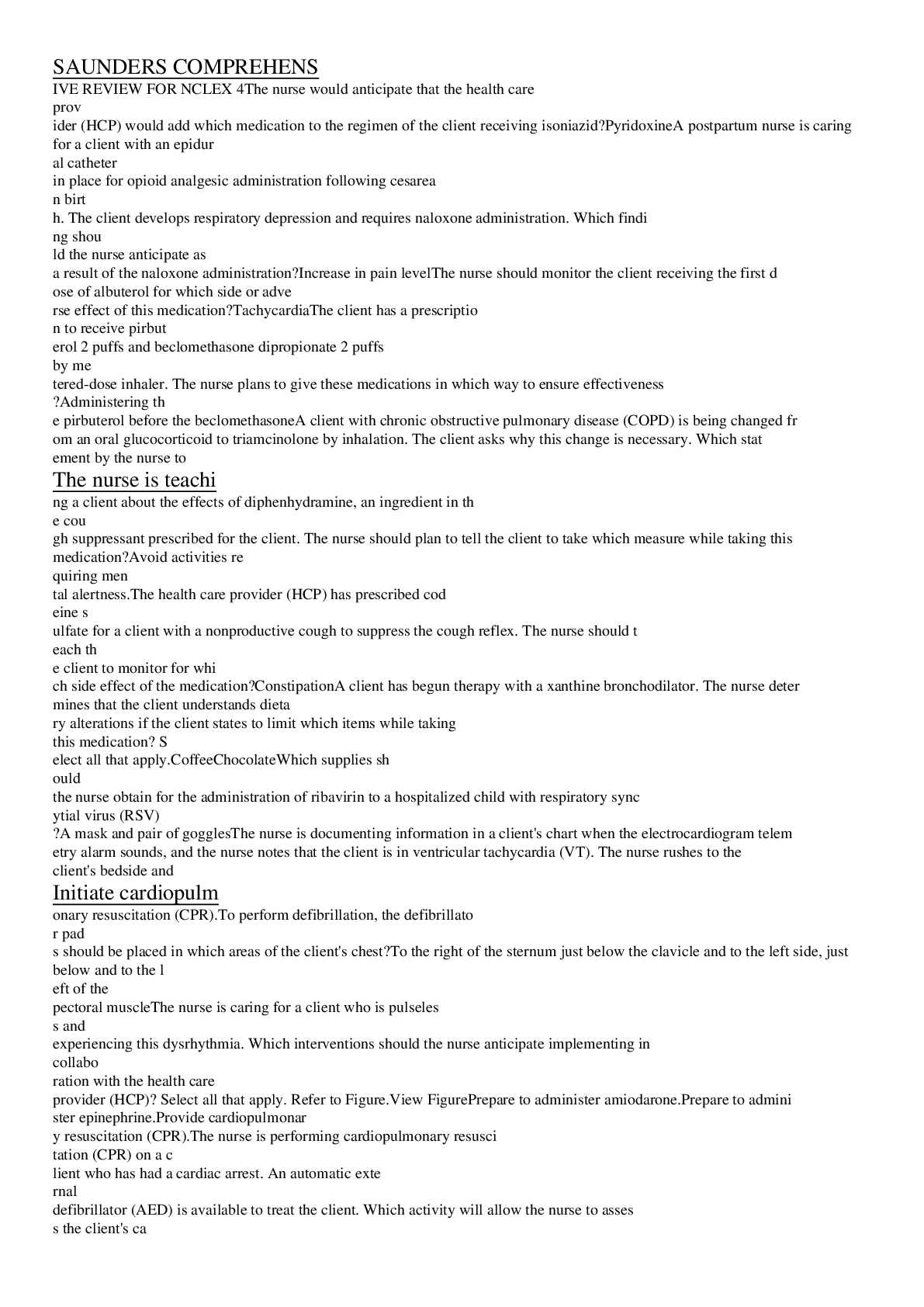
Also available in bundle (1)

SAUNDERS COMPREHENSIVE REVIEW FOR NCLEX 1 - 5
SAUNDERS COMPREHENSIVE REVIEW FOR NCLEX 1 SAUNDERS COMPREHENSIVE REVIEW FOR NCLEX 3 SAUNDERS COMPREHENSIVE REVIEW FOR NCLEX 4 SAUNDERS COMPREHENSIVE REVIEW FOR NCLEX 5
By Martin Freeman 3 years ago
$36.5
4
Reviews( 0 )
Document information
Connected school, study & course
About the document
Uploaded On
Jun 14, 2020
Number of pages
0
Written in
Additional information
This document has been written for:
Uploaded
Jun 14, 2020
Downloads
2
Views
73

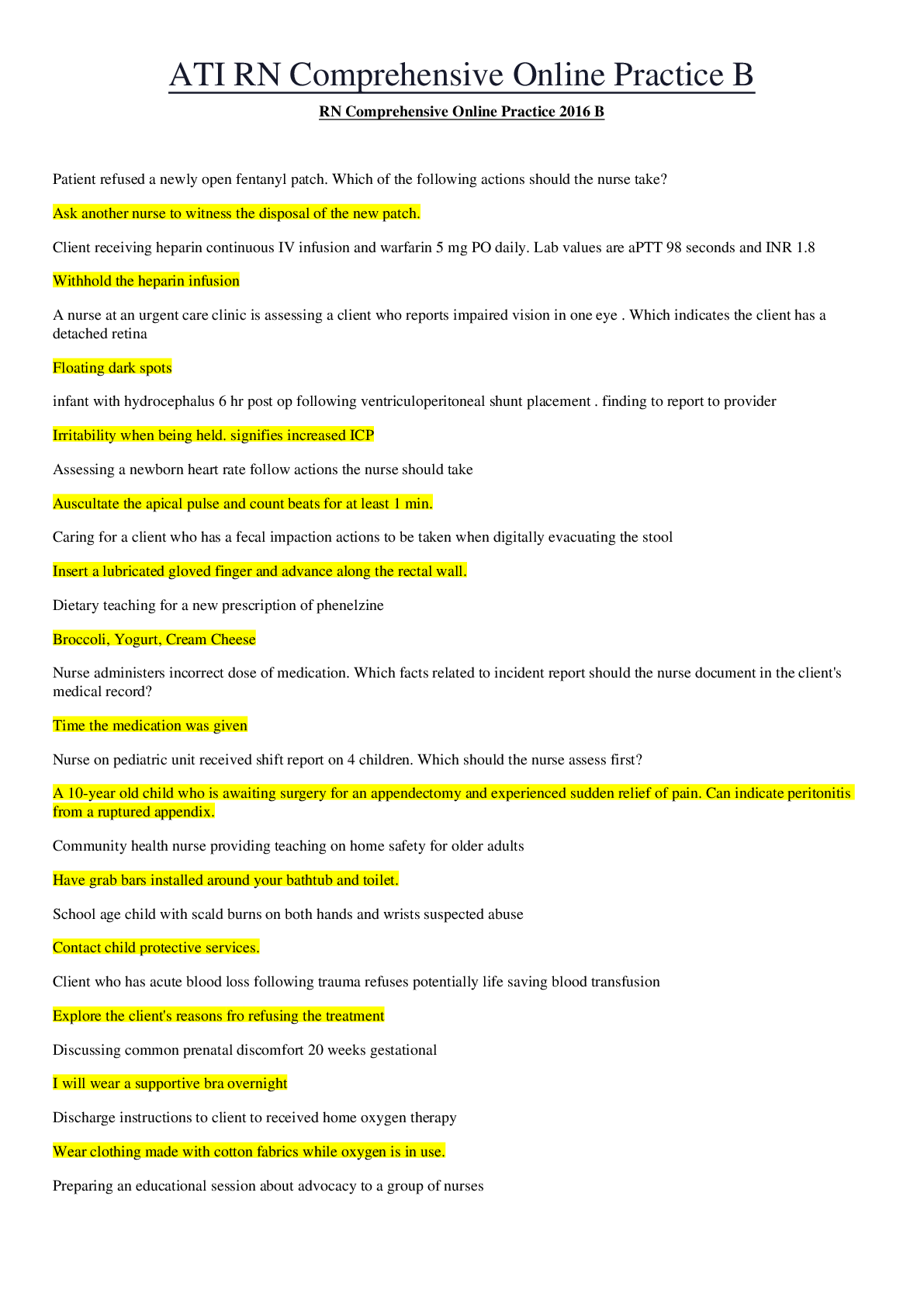
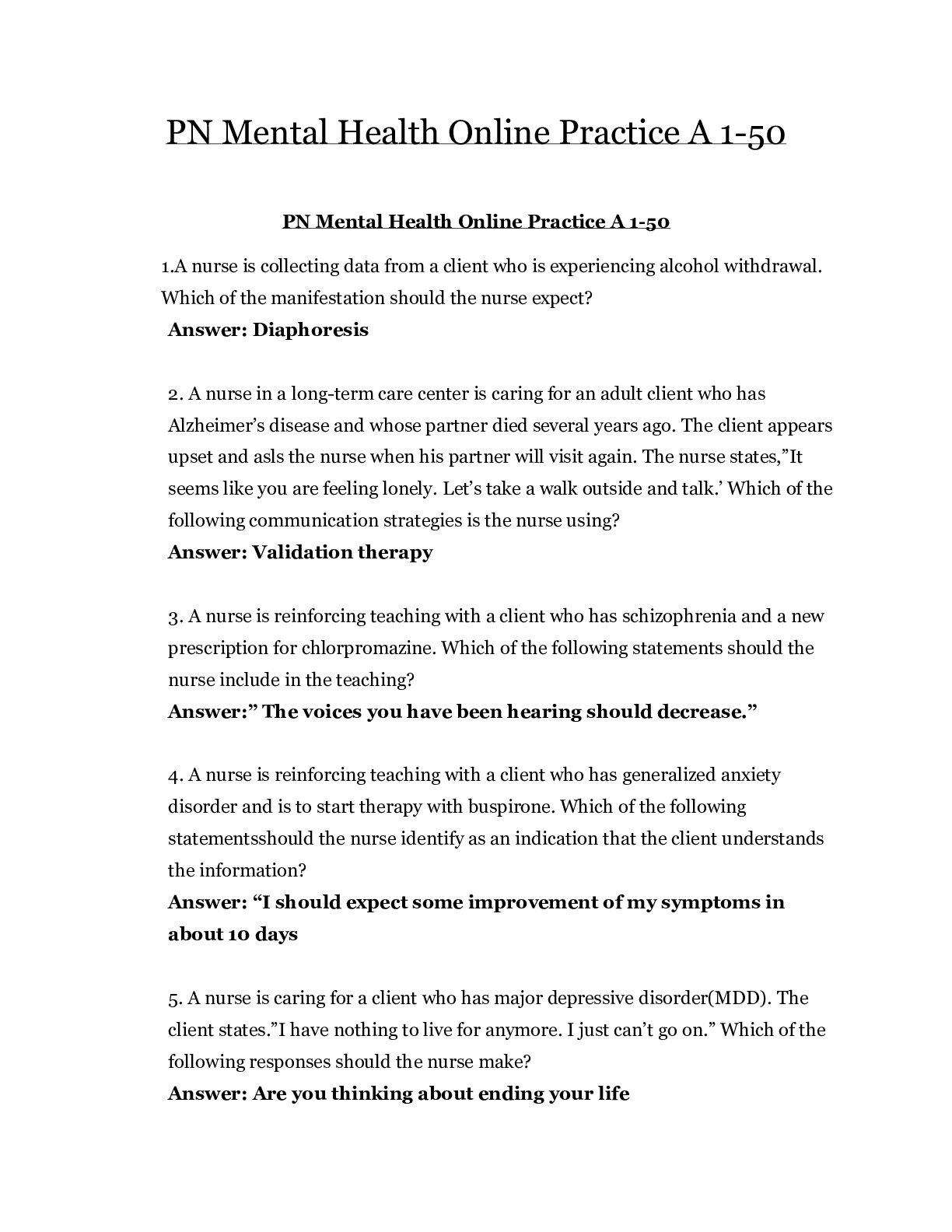
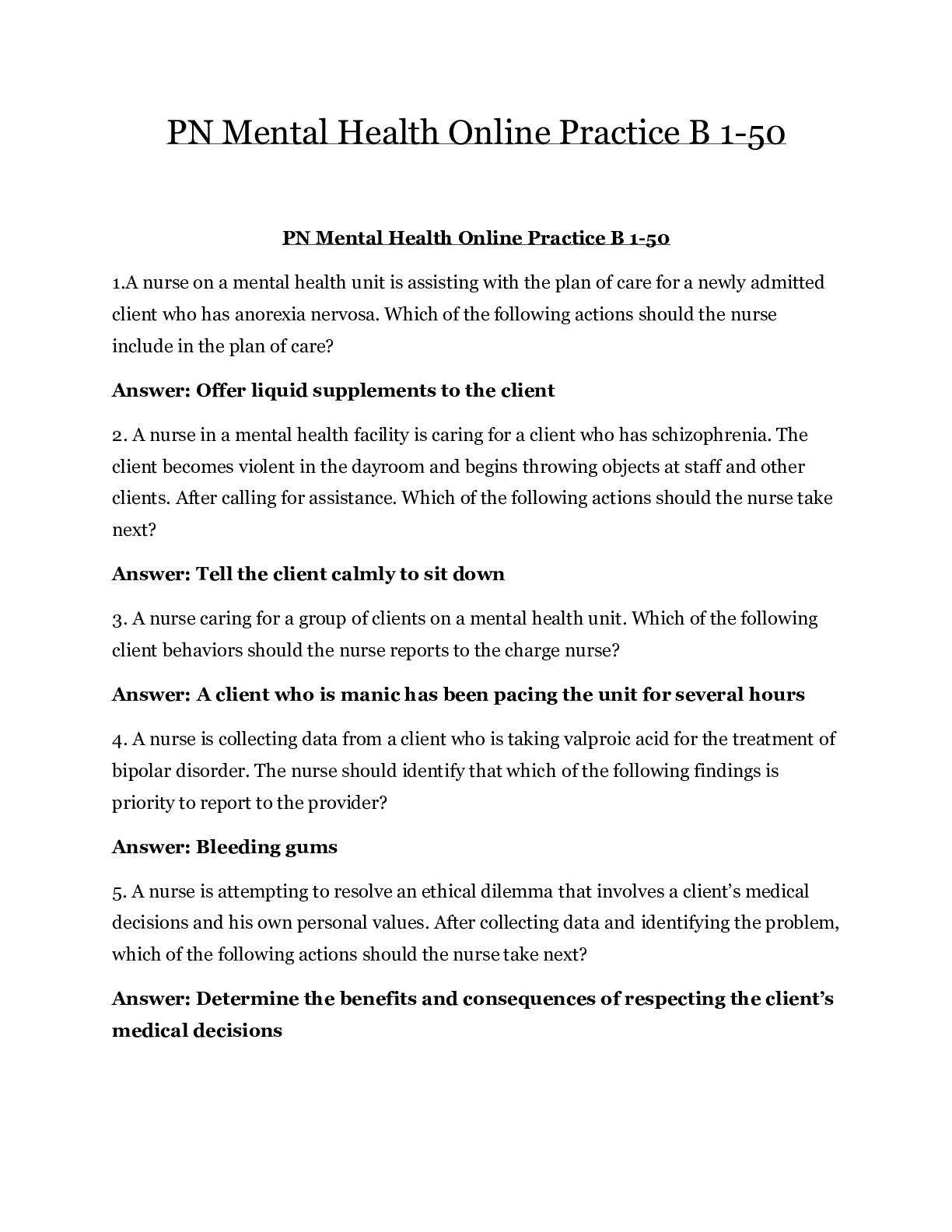
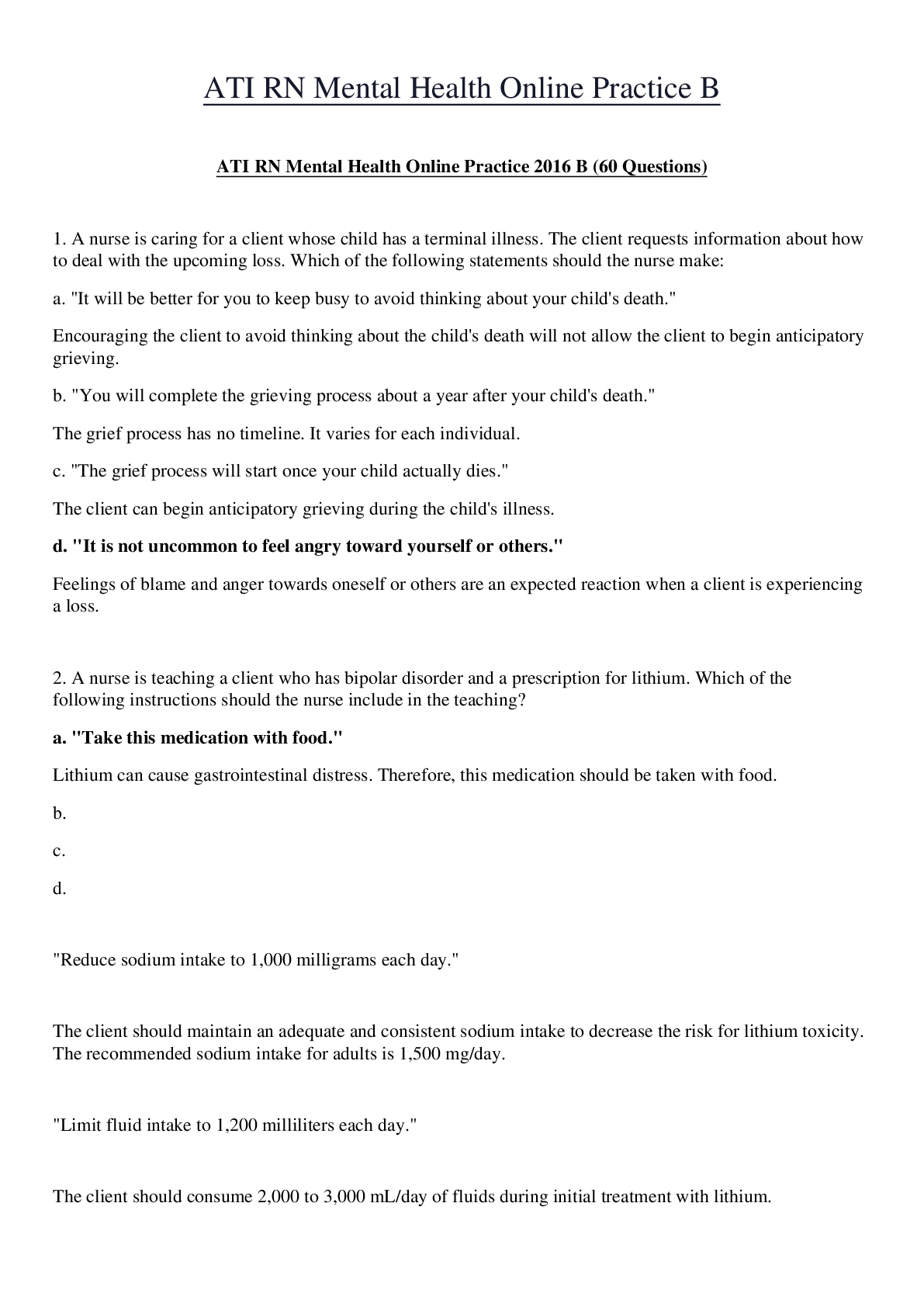


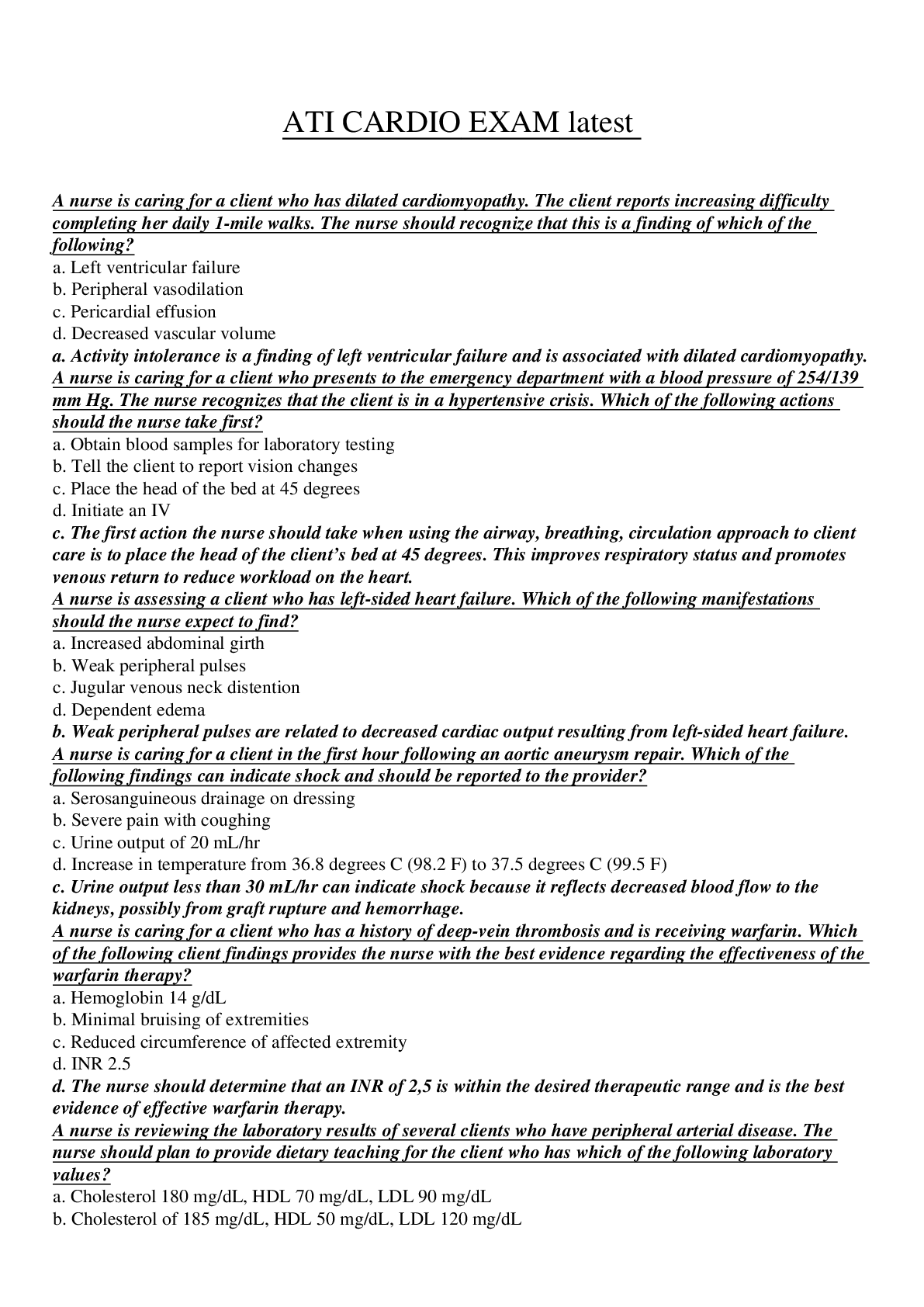
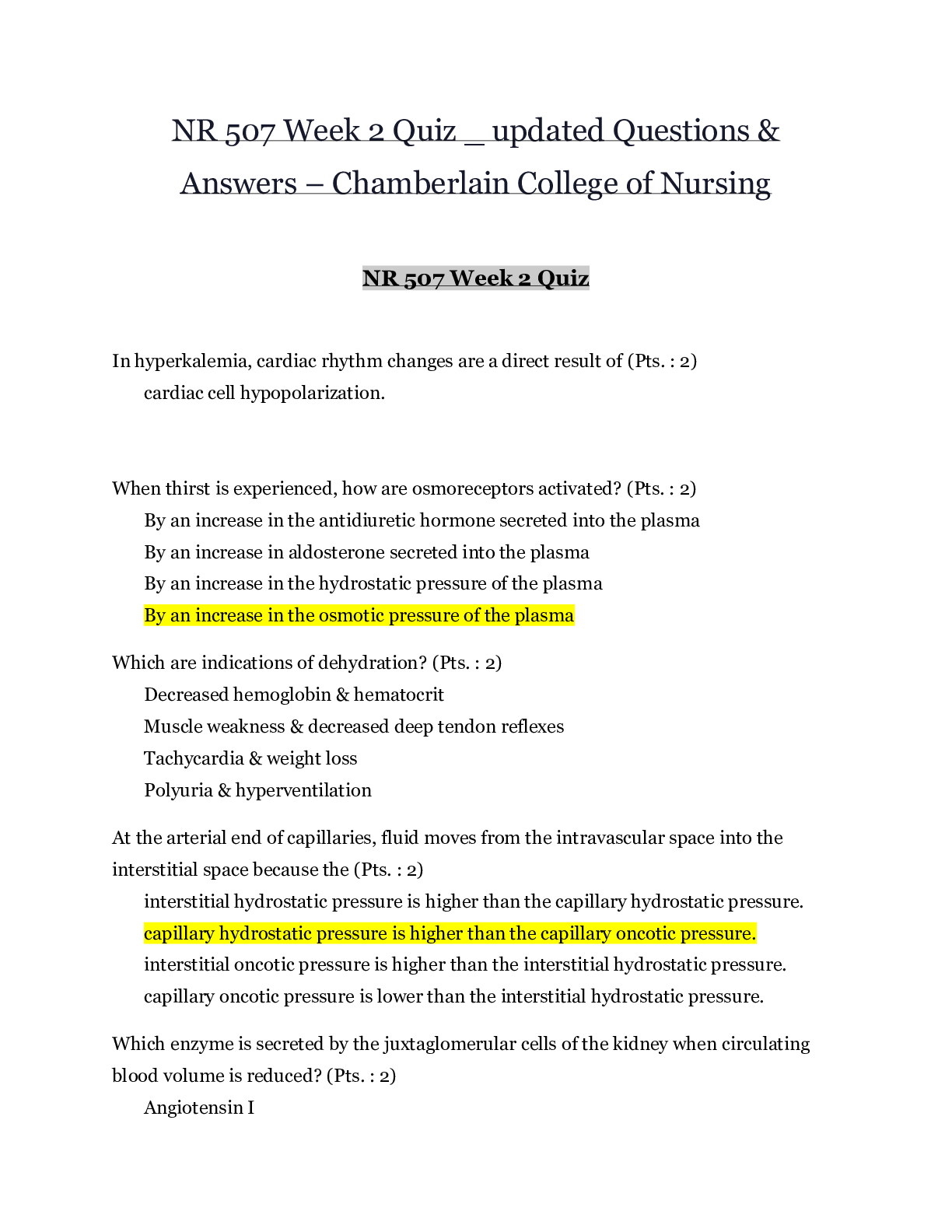
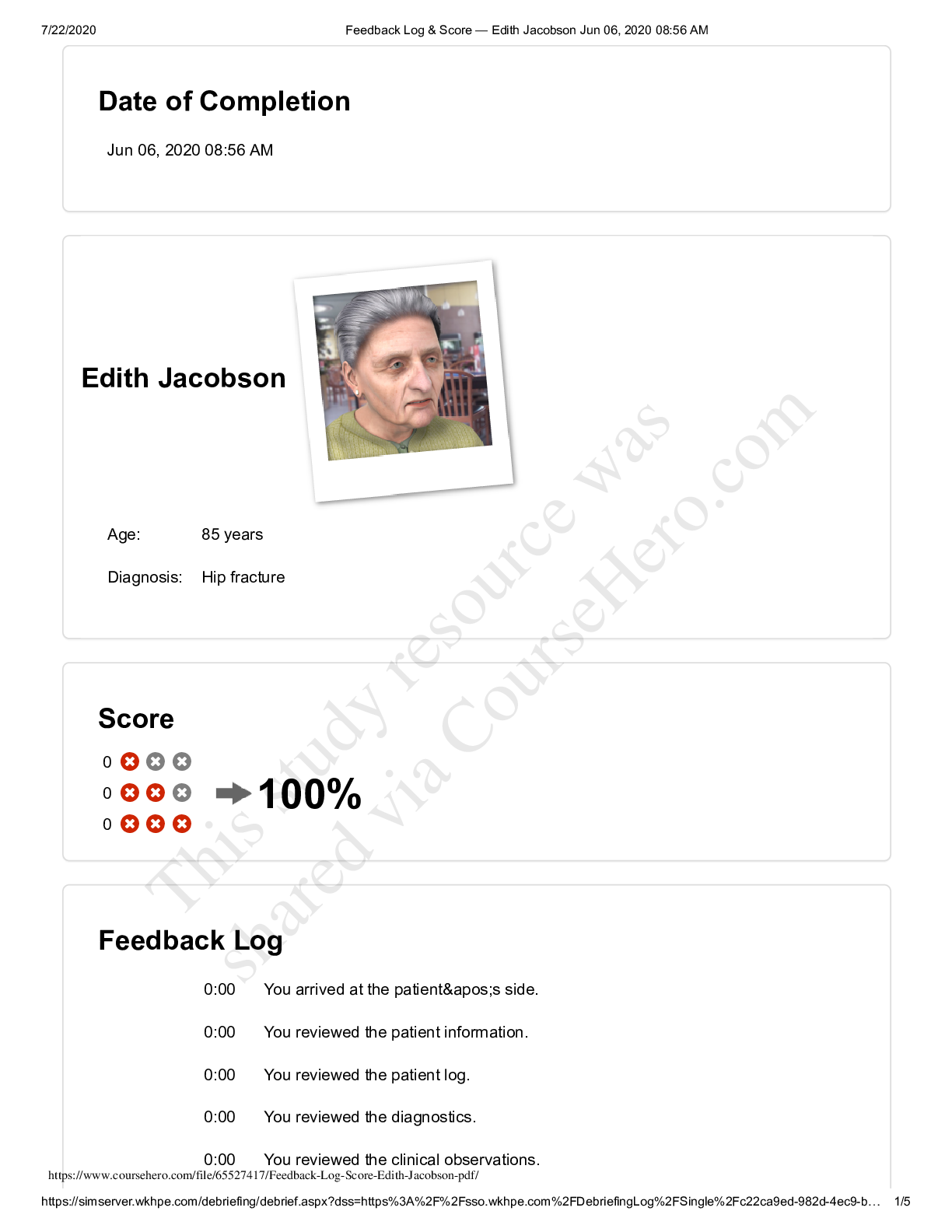
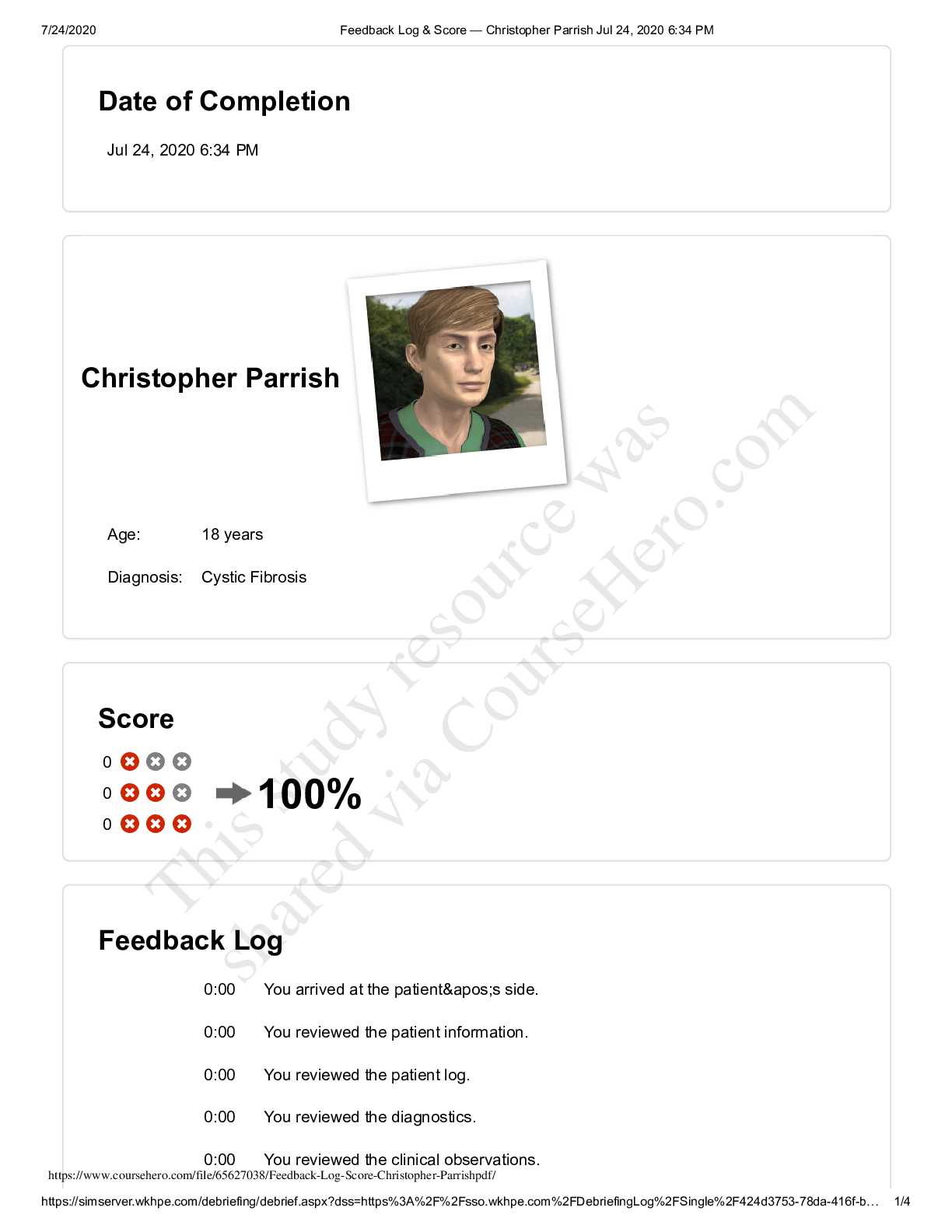
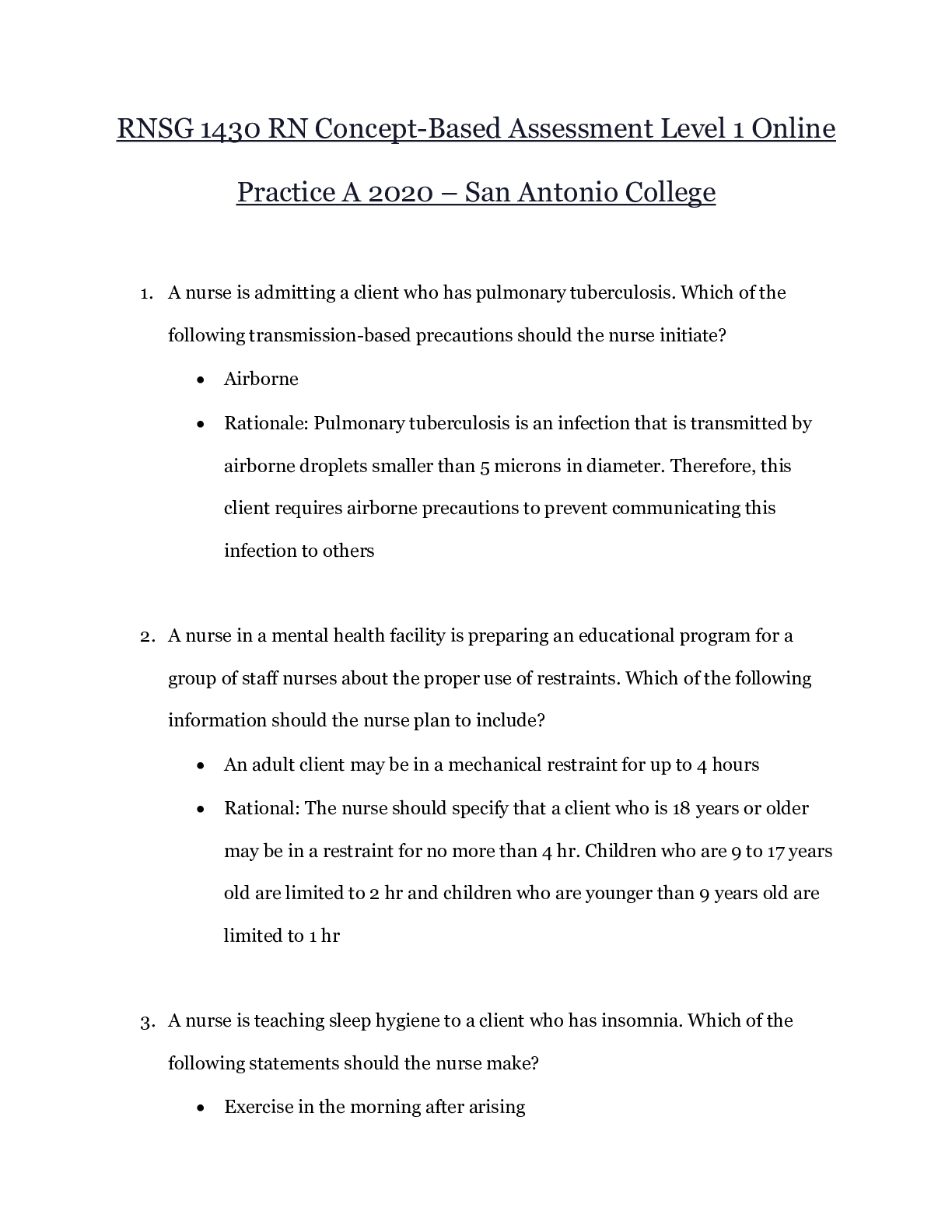


 – CHAMBERLAIN COLLEGE OF NURSING.png)
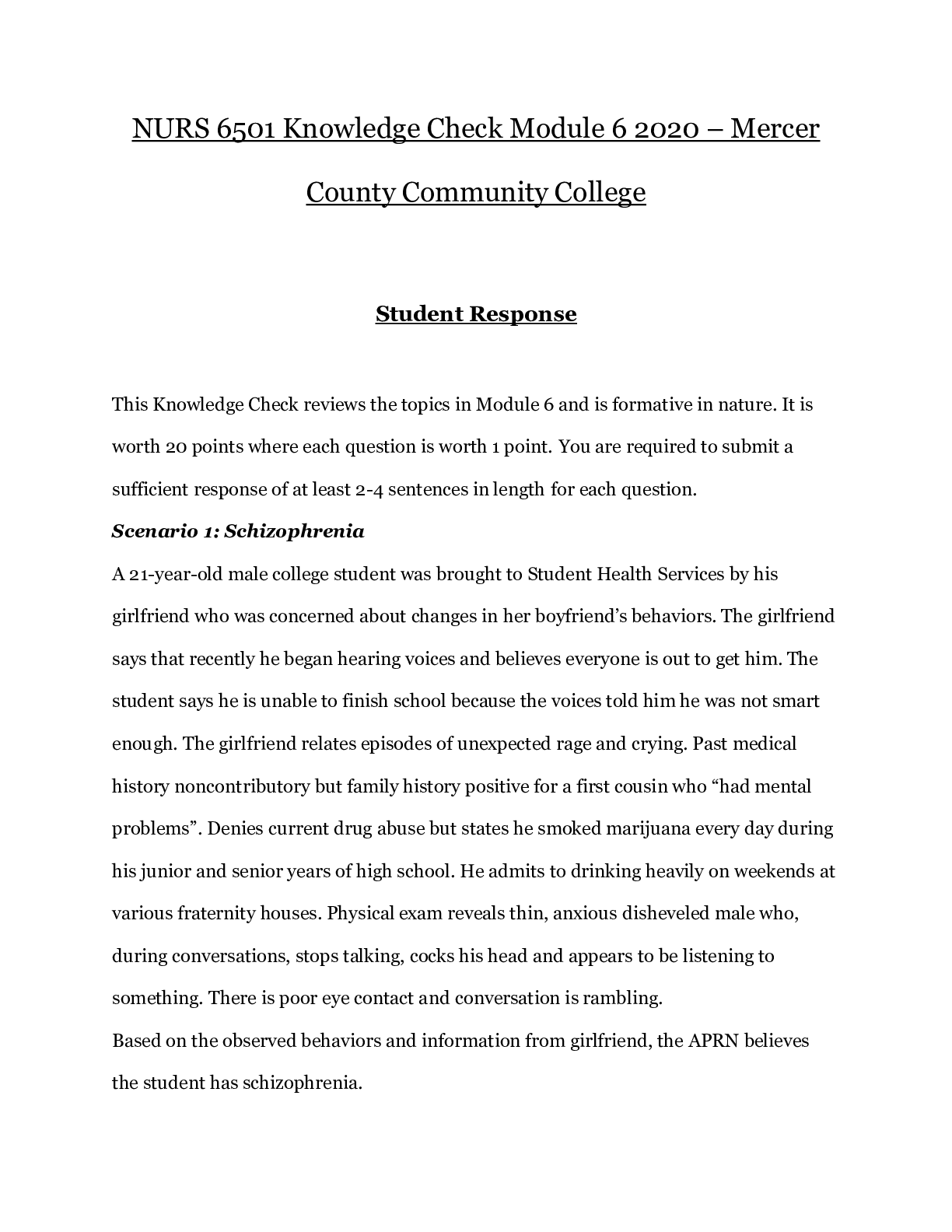
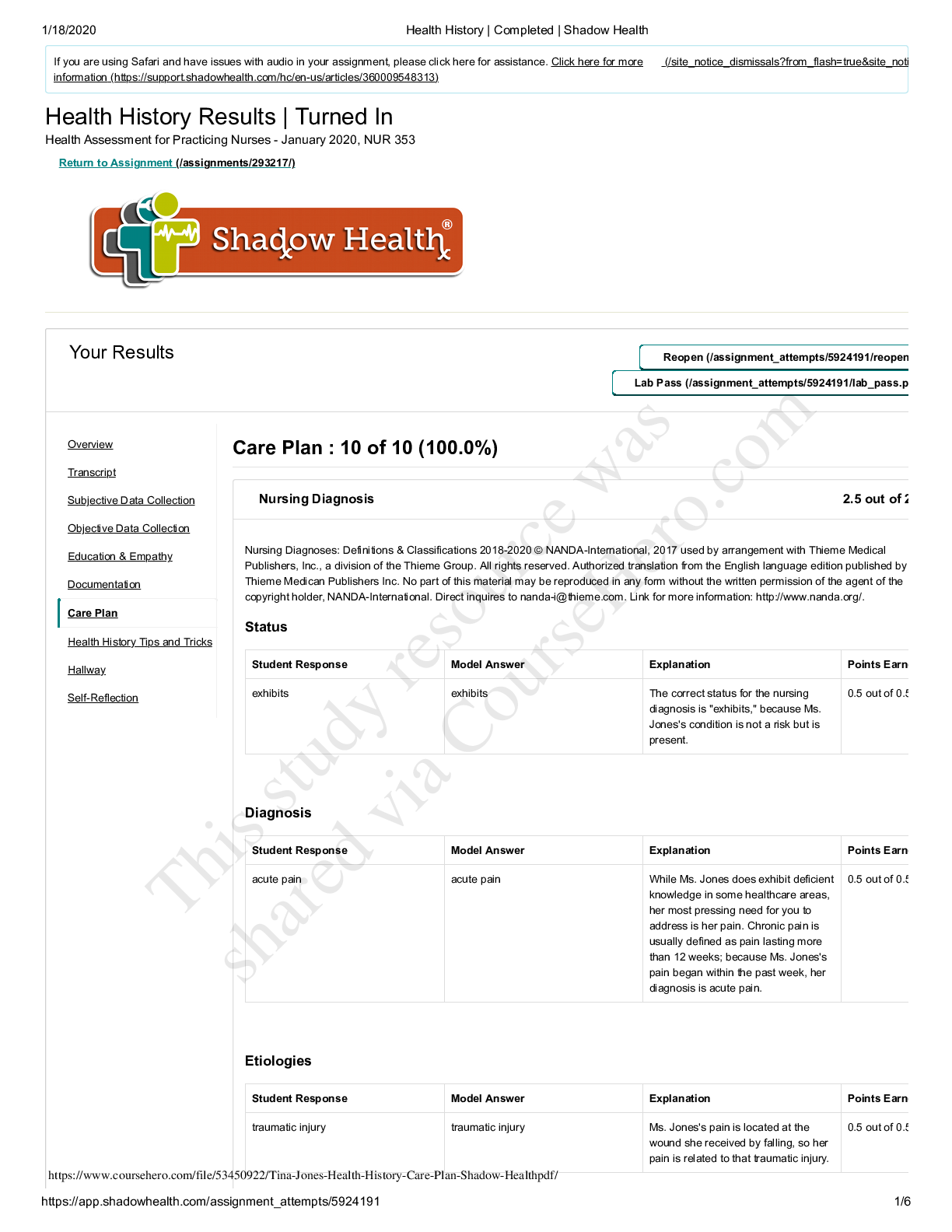

.png)
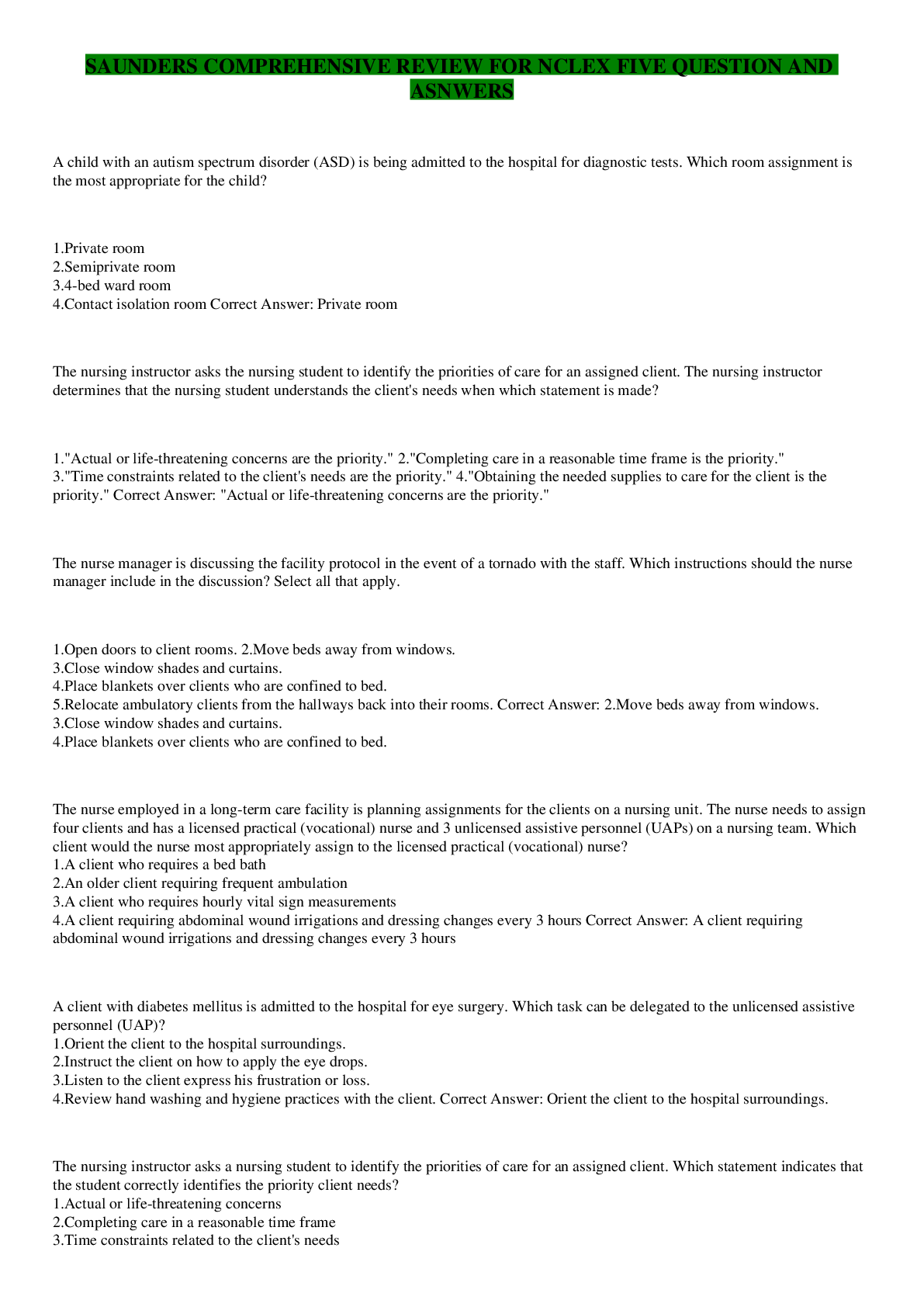
.png)
.png)
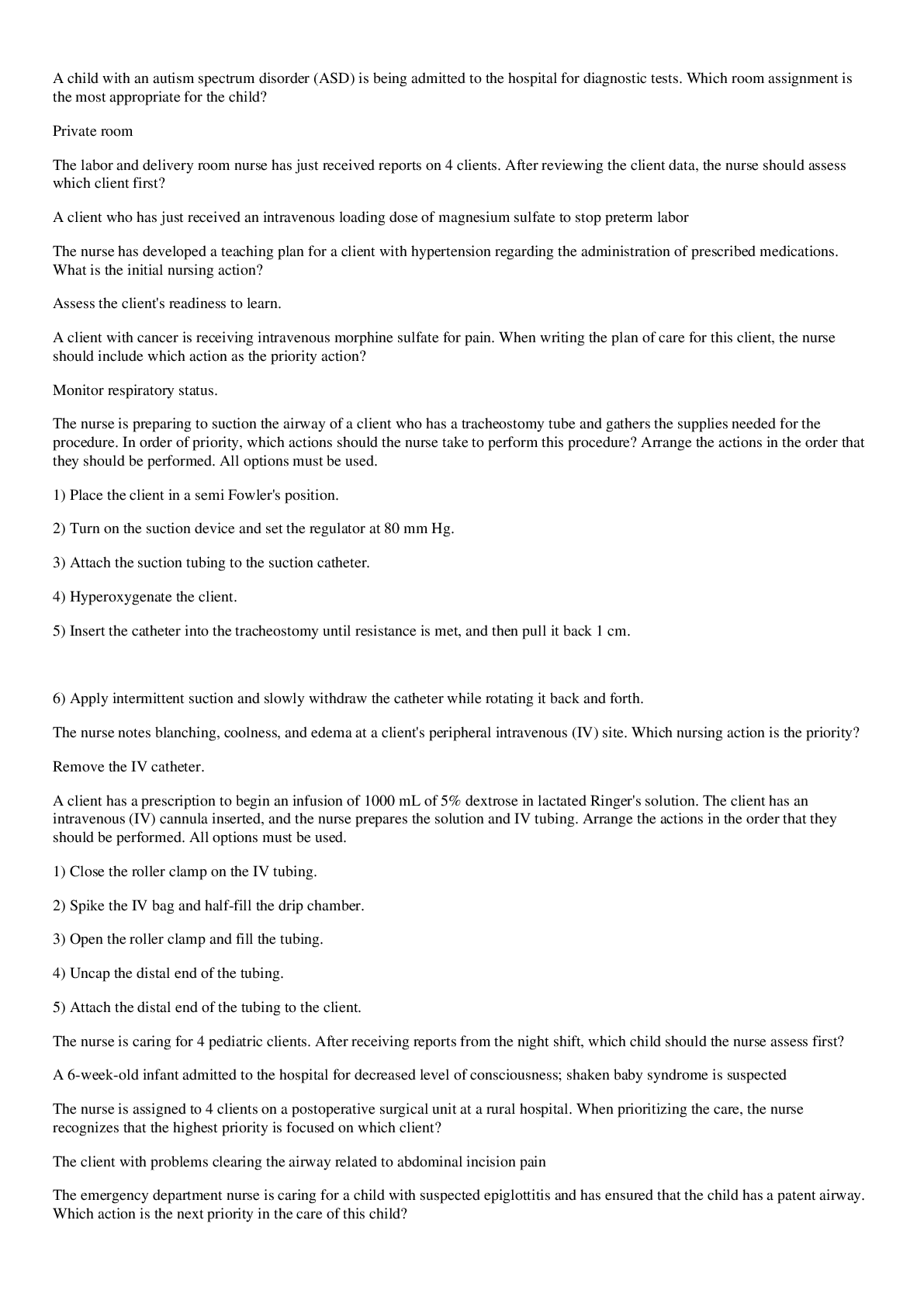
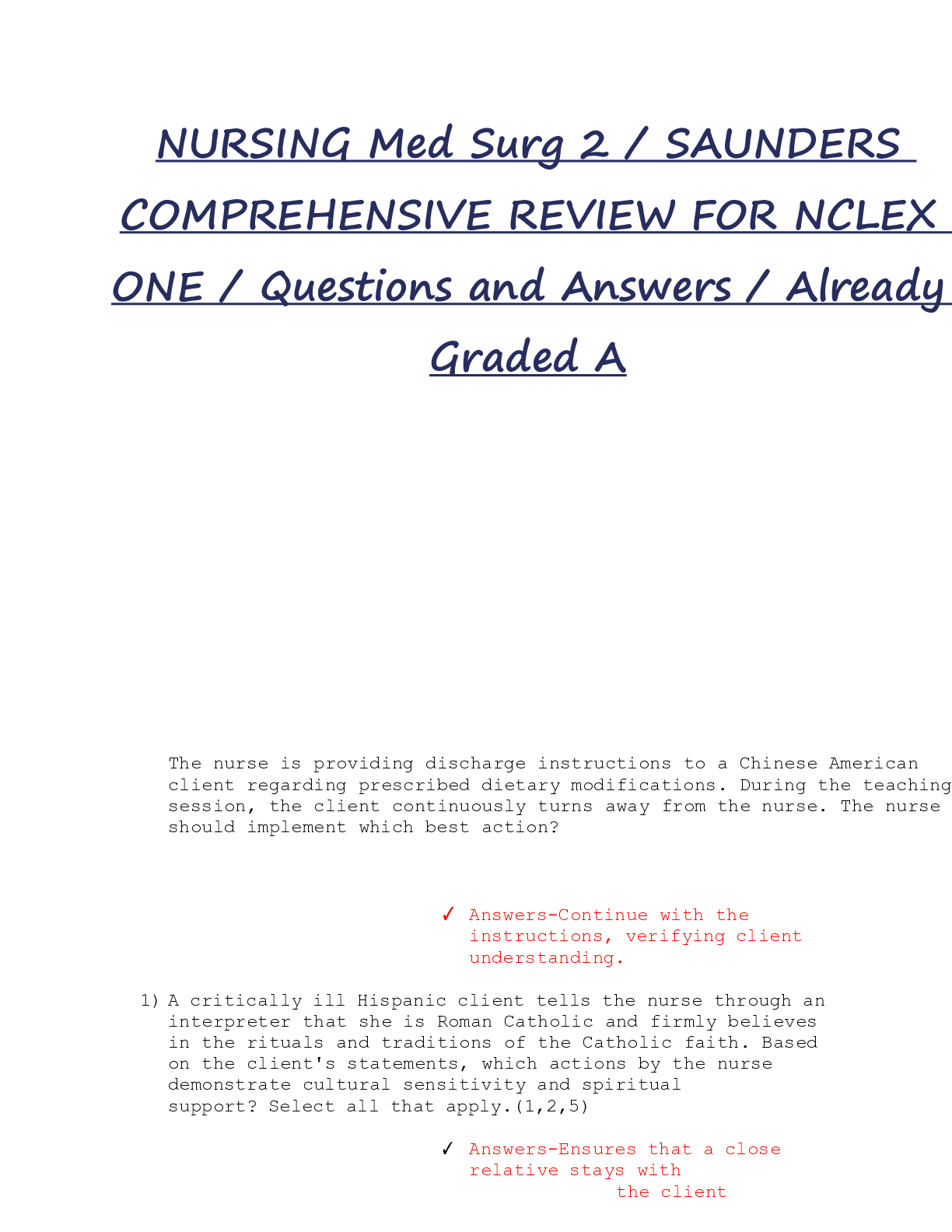
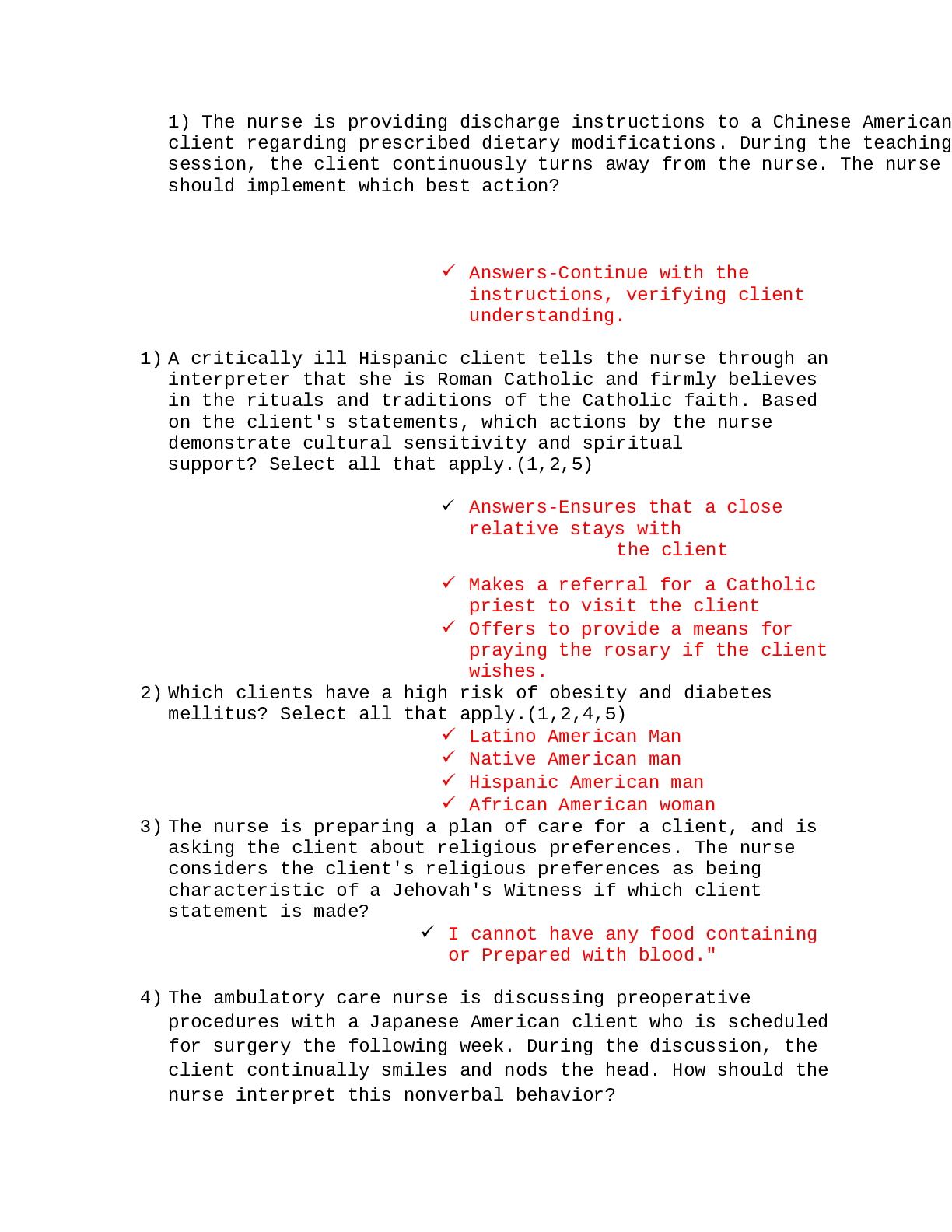
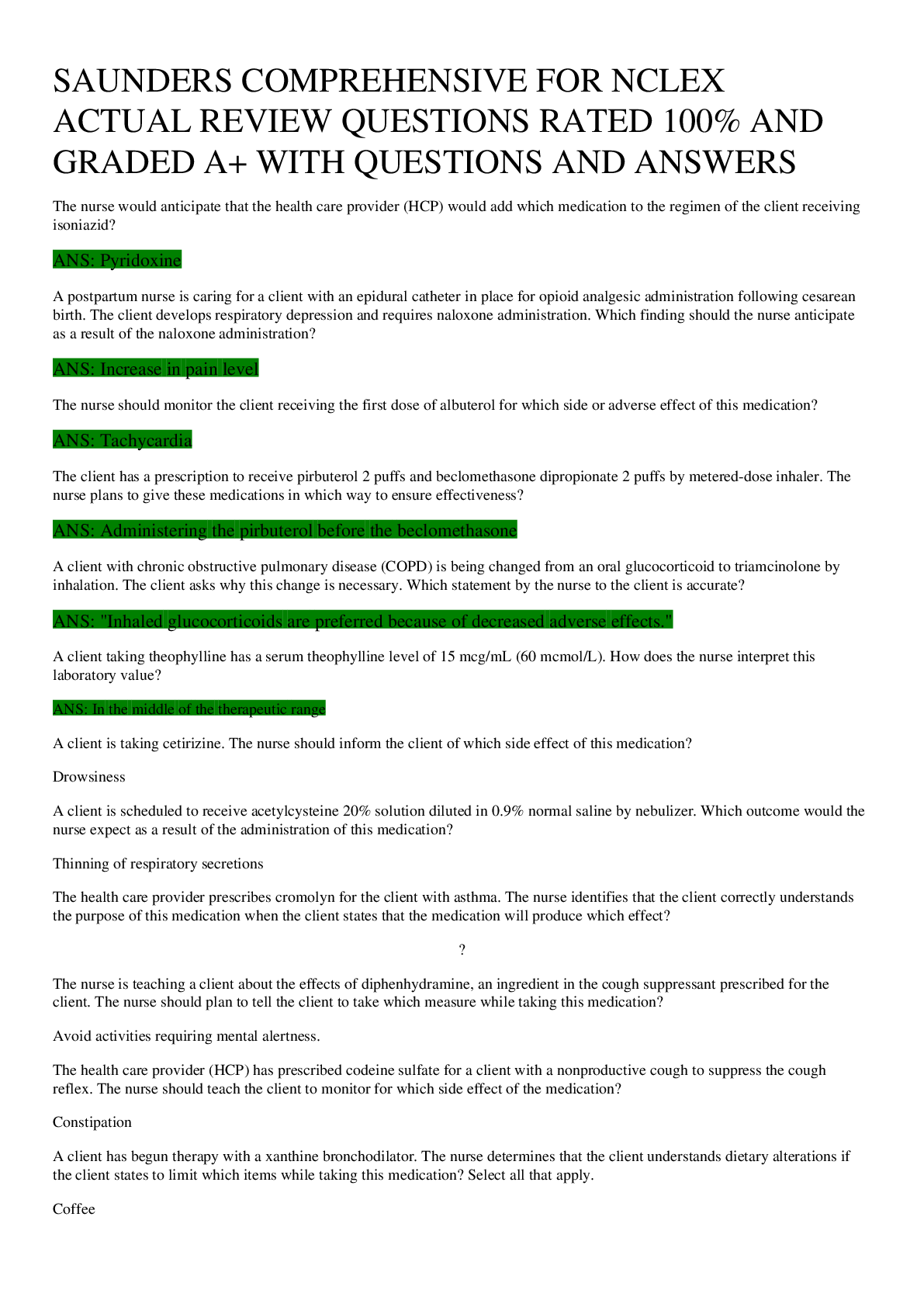
.png)
